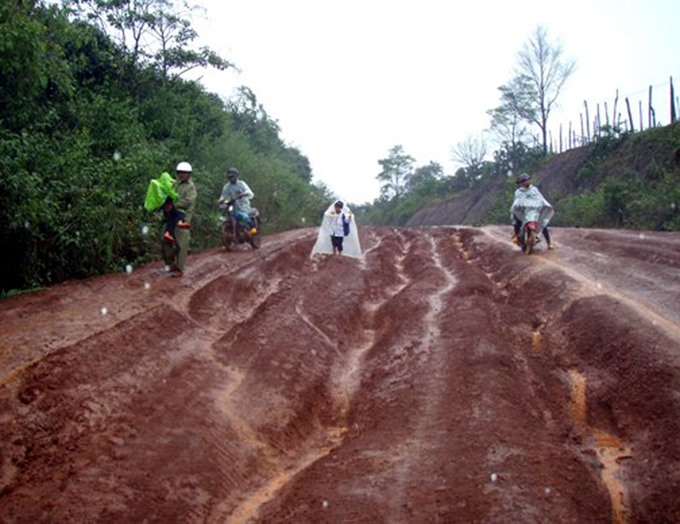Fifth grader Dinh Thi Phuong and her friends go swimming every day, but it is not a recreational activity.

A young boy (centre) braves the weather and bad road conditions to go to school in the Central Highlands province of Dak Nong. — Photo thethaovanhoa.vn
They go swimming because they have no other way to get to school.
Many children in remote and poor areas of the Central Highlands have to go the extra mile to continue their studies, dealing with the heavy constraints of long distance, inadequate transport infrastructure and poverty.
An article in the Gia đình xã hội (Family and Society) newspaper yesterday said many children still have to swim or take small and old boats to cross rivers and streams to reach their schools.
It quoted Phương, a resident of Gia Lai Province’s An Trung Commune as saying: “My friends and I swim in the the river to go to the school in the dry season. But in the rainy season, the water level is high, we have to go by boat although it’s very expensive.”
The fifth-grader’s parents have to pay about VNĐ20,000 (88 cents) a day for round-trip on the boat. Transportation costs of VNĐ400,000 ($18) a month per child is a steep sum for families in poor areas. Since all parents cannot afford this, many children continue to swim across the river even during the rainy season.
If the water level gets too high and dangerous, the students stay at home
Đinh Văn Hư, a seventh-grader in Đắk Lắk Province’s Ea Đá Commune, said his parents farm in fields about 10km away, because the soil in fields near their house was too arid.
If Hư wants to attend school, he, his younger brother and sister have to take care of themselves, including cooking and washing. The other choice is to drop out and follow their parents to the farm.
The parents buy dried fish, vegetables and instant noodles for their children every week, but this is only enough for lunch and dinner.
Hư said, “For us, breakfast before school is something very rare.”
Teachers to the rescue
Teachers in the region also have to overcome a lot of difficulties to stay and teach their students with inadequate facilities.
There are only four classrooms in Cư Pui 2 Primary School in Đắk Lắk Province’s Cư Pui Commune. All the seven teachers in the school from northern provinces.
Nguyễn Thị Nhuần, one of the teachers, said she and other teachers lived next to the classrooms.
Their rooms are roofed with steel plates.
“It’s very hot during sunny days and leaks water when it rains,” she said.
Another teacher, Đặng Thị Ly, said: “I was very sad when I first came here. There was nothing except forests around the classrooms.”
After she became familiar with locals, she felt better, Ly said.
In this area, there are many reasons for students to stay away from school, according to Trịnh Thị Phương, another teacher. It can rain badly, children might not be able to cover the long distance everyday, and their parents might be too poor.
Phương said she and other teachers visited the students’ houses often to encourage them to resume their studies.
“We also encourage our students by sharing our lunch with them. Many students only have rice and salt for their lunch,” she added.
Cutting the distance
Many localities in the region are trying to deal with the problem students being forced to stay away from schools because of the distance by building classrooms in every village.
Across the Central Highlands, there are about 39,800 classrooms with 74,600 teachers.
Trần Phú Vinh, head of Education and Training Office of Lâm Đồng Province’s Đam Rông District, said: “It’s a good decision,” that would create many favourable conditions for students.
In Đắk Lắk Province, the local administration has set up 12 boarding schools for 1,400 poor students.
A policy issued in 2016 to support poor students in remote areas to attend school by providing the families with 40 per cent of the basic wage has also helped.
The basic wage is VNĐ1.3 million ($57) per month now, which means families are eligible to receive about VNĐ520,000 ($23) each student per month.
Many organisations and individuals have also provided financial aid to build roads and bridges for local students, but much more assistance from all sectors is needed to remove all the difficulties that still stand in the way of many students going to school in the Central Highlands.
VNS